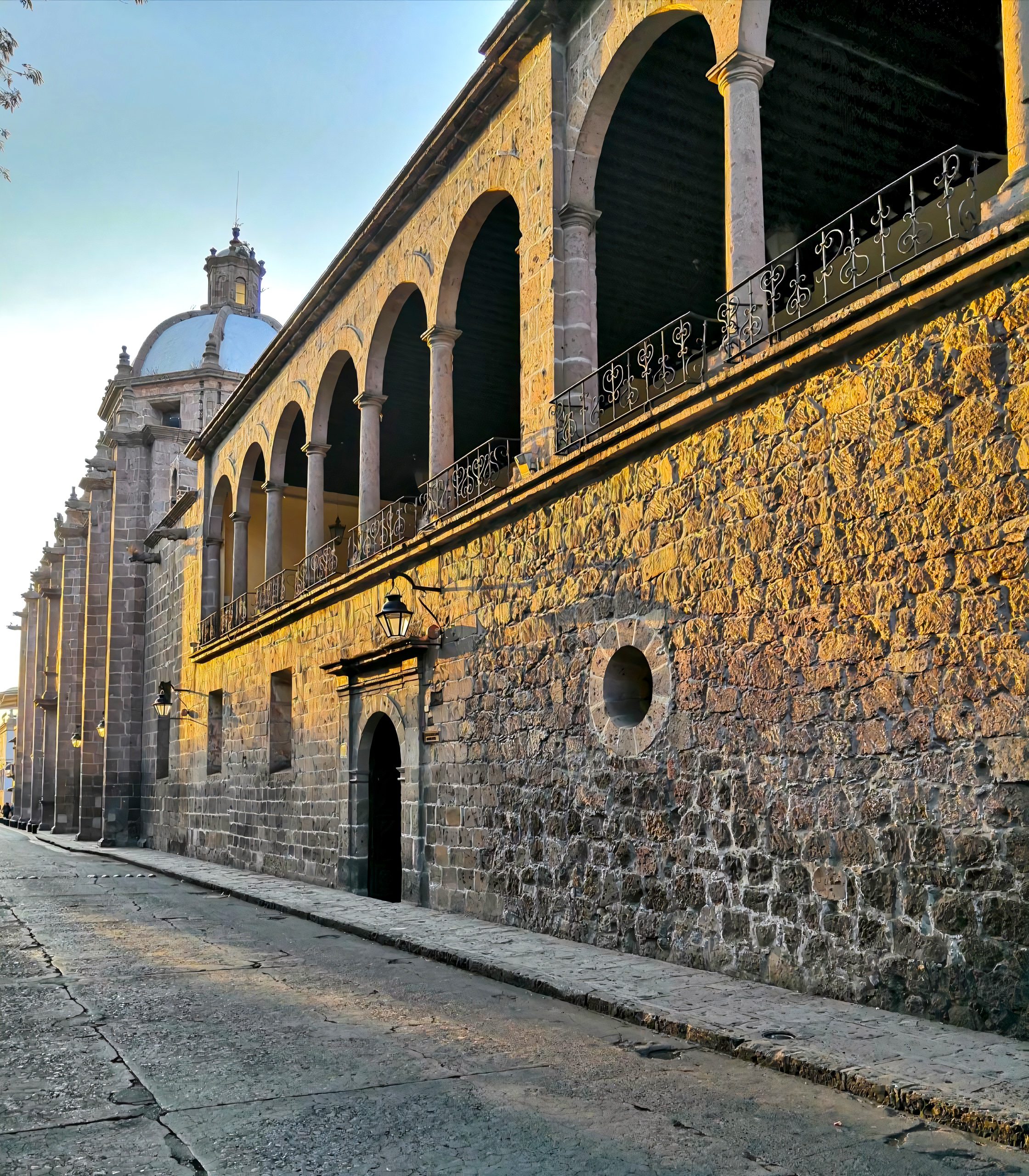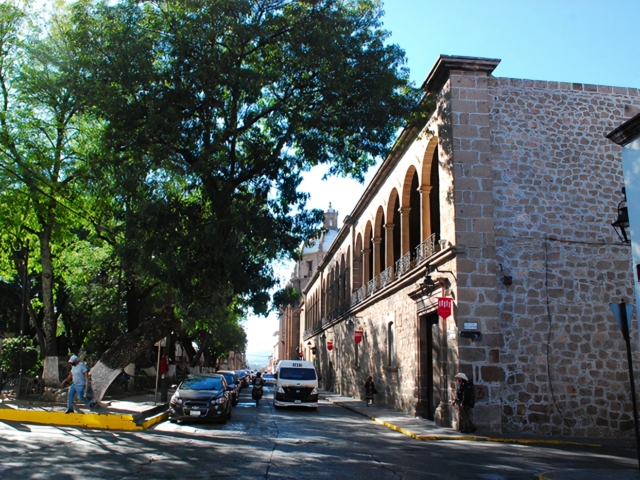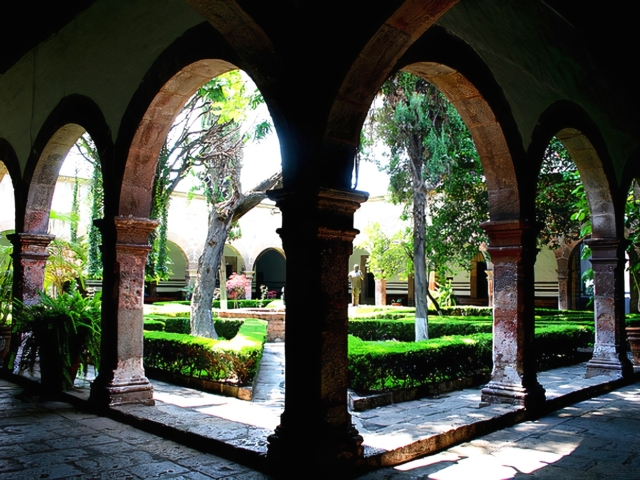
Adress
Santiago Tapia 334 Centro, Centro histórico, 58000 Morelia, Michoacán, México.
GPS
19.704955546463, -101.19442999363
Phone
Send an Email to
Monday
08: 00 – 21:00
Tuesday
08: 00 – 21:00
Wednesday
08: 00 – 21:00
Thursday
08: 00 – 21:00
Friday
08: 00 – 21:00
Saturday
08: 00 – 14:00
Sunday
CLOSED
KNOW MORE PLACES
VISITA OTRAS LOCALIDADES
In 1743, the Colegio de Niñas de Santa Rosa de Santa María was founded in the city of Valladolid, Michoacán, in the same building that is now occupied by the Conservatorio de las Rosas. The building had previously belonged to the Dominican Convent of Santa Catalina de Siena, an institution that stood out in the former province of Michoacán for its intense musical activity. The Colegio de Niñas was also distinguished by the role that music teaching played there, which is why it is considered today as the most remote antecedent of the Conservatorio de las Rosas.
The school operated until 1870, when it was finally closed after almost a decade of vicissitudes and partial closures. The building was then expropriated and used for different purposes by the government. Thirty years later, in 1904, the San Gregorio Magno School of Sacred Music was opened in Morelia, with the aim of providing professional training for church musicians. This school never had appropriate facilities and its existence was short-lived: it was closed along with other clerical schools in 1914. But that same year the Orfeón Pío X was organized in the city, which represented the continuity of the closed school, since the members of the choir were provided with careful musical training.
In 1921 the Orfeón became the Official School of Sacred Music of the Archbishopric of Michoacán, where the first titles of “License of Gregorian Chant” and “Master of Composition” were awarded in 1926. Among the disciples who graduated in 1927 was Miguel Bernal Jiménez, who the following year was sent to Rome to specialize in organ and upon his return to occupy the position of teacher of this instrument. His return meant the beginning of a new era in the teaching of sacred music in Morelia. Between 1930 and 1934 the School operated in the Rosas building, but was again evicted, so it continued its work in improvised premises. From 1938, under the artistic direction of Miguel Bernal Jiménez, a new and more ambitious curriculum was designed and the institution began to be considered a Higher School of Sacred Music and to award, in addition to the “Master's Degree in Composition” and “Bachelor's Degree in Gregorian Chant”, the “Bachelor's Degree in Organ”.
From 1941 the School moved to the Rosas building, but it was not until 1950, after the Civil Association of the Conservatory of the Roses was established, that the building was finally ceded to the School, which over time would move away from its ecclesiastical origins and become known as the Conservatory of the Roses.
In 1986, the Conservatorio de las Rosas began a period of radical transformation, when it was structured according to its founding statutes of 1950. The Council of Associates was established (which had not existed after the death of Miguel Bernal Jiménez in 1956) made up of distinguished representatives of Morelian civil society. Manuel Contreras Reyna then took over the presidency and appointed Jesús Carreño, one of Miguel Bernal Jiménez's most notable disciples, as director of the school. That fact alone was already innovative, since it implied the definitive institutional separation between the Conservatory and the Church. During the last decades, since the death of Miguel Bernal Jiménez, Father Marcelino Guiza had been in charge, who ended his term with the appointment of Maestro Carreño. Father Guiza managed to keep the institution alive, facing situations of enormous adversity. His key collaborators in this task were the teachers Gerhart Muench, Bonifacio Rojas and Rubén Valencia, among many others. However, the Conservatory's fundamental mission was to train musicians for religious service, a mission that had ceased to make sense since the Vatican Council of 1962, after which music became a secondary factor in the profession, and the church no longer required highly specialized musicians in disciplines such as Gregorian chant, classical vocal polyphony or the organ.
The renovation that began in 1986 continued with the restoration of the central building of the Conservatory, which was almost completely unusable, even without a roof. The new Board of Associates and the community of teachers became aware that a deep academic transformation was necessary, which would review the very mission of the institution. It was from then on that the Conservatory focused on the professional training of musicians, apart from any religious objective. The teachers Ana María Martínez and Eduardo Montes played a definitive leadership role in the process. From 1990, the presidency of the Board of Associates was occupied by Eng. Miguel Bernal Macouzet, who held the position for a decade. He was succeeded by Alfonso Mier, Francisco Johnson and Francisco Bernal Macouzet. From January 13, 2012, it was presided over for the first time by a woman: Dr. Carmen Alicia Dávila, a member of the board for more than a decade. Its current President is C.P. Ricardo Casiano Alba, a renowned public accountant and specialist in Forensic Auditing, was elected in November 2015, beginning a new era within the Conservatorio de las Rosas, with transparency and accountability as its fundamental principles.
In 1992, Maestro Eduardo Mata was appointed director, who contributed to energizing the institutional renovation and generating a process of total reinvention of the project. He was succeeded by Manuel de Elías and Gerardo Cárdenas. Beginning in 1994, the teaching staff was radically transformed, consolidating the different musical disciplines. Many Mexican and foreign teachers joined the institution, whose work quickly turned the Conservatory into a cutting-edge institution in music education at a national and international level. It was a complex process that required not only the consolidation of the teaching staff, but also a total renovation of the study plans. And all of this made no sense without the construction of new spaces and their equipment. A library specialized in music was founded, the building adjacent to the cloister was restored, which expanded the capacity of the Conservatory by one hundred percent; likewise, the percussion area was created, with an investment in equipment that placed the institution at the forefront in the field. Shortly afterwards, the first Bachelor's Degree in Music and Humanities in the country was launched, giving structure to the education of students from an early age. Later, the Bachelor's Degree in Music was established with more than 20 specialties.
The transformation process was completed with the acquisition and restoration of a new building in the Rose Garden complex, and the creation of new work areas and an audiovisual room that allowed for the multiplication of teaching resources. There are many teachers who contribute and have contributed their knowledge and experience to the development of the institution.. Una figura fundamental del crecimiento del Conservatorio es el maestro Carlos Prieto, quien se integró como Presidente de la Fundación Conservatorio de las Rosas, creada con el propósito de apoyar el desarrollo de la institución.
The most ambitious growth project of the 1990s was the construction of the Carlos Prieto Campus, a modern building designed by architect José Moyao, which allowed the creation of preschool and secondary levels, completing the educational offer with the Mariano Elízaga primary school, which already existed. The academic project of the basic levels was radically transformed to make way for a comprehensive education model with a humanistic approach, which includes social sciences, exact sciences, technology, English, sports, music and arts. The Conservatory also restructured its organization chart, adopting a university structure whose highest figure is the Rector, with Vice-Rectors, Directors of each level and Coordinators of areas. In 2004 the Council of Associates appointed Germán Romero as Rector, who until then served as coordinator of the Composition department and teacher of the Conservatory. In 2009, the notable composer Javier Álvarez was appointed rector, who brought to the institution his experience in international management and his deep knowledge in teaching composition. In 2019, Maestro Raúl Olmos, an outstanding guitarist in international festivals and a professor with an extensive curriculum in public administration, was appointed rector. He still holds this position.














